Ijraset Journal For Research in Applied Science and Engineering Technology
- Home / Ijraset
- On This Page
- Abstract
- Introduction
- Conclusion
- References
- Copyright
Optimizing Machine Selection and Cost of Quality: A Comprehensive Approach for Enhanced Industrial Efficiency and Economic Growth
Authors: Rohit Kumar, Nishant Singh Kushwah
DOI Link: https://doi.org/10.22214/ijraset.2024.60745
Certificate: View Certificate
Abstract
In today\'s modern industrial economy, selecting suitable machinery and efficiently managing quality costs are critical for achieving sustainable growth and competitiveness. This research paper presents a comprehensive approach to optimizing machine selection and cost of quality (COQ) within industrial operations. The study commences by delineating the criteria for machine selection and determining their respective weights using the Analytic Hierarchy Process (AHP). Subsequently, the VIKOR method is applied to select the most suitable machine based on the established criteria and weights. Moreover, the paper explores the concept of COQ, underscoring its importance as a performance measurement tool for organizations. The research investigates various strategies for minimizing quality-related expenses and maximizing benefits, including defect prevention, quality assurance, and continuous improvement initiatives. A case study analysis, focusing on the selection between mechanical cutting CNC machines and laser cutting CNC machines, provides practical insights into the implementation of the proposed methodologies. Real data analysis of cost and quality metrics, coupled with formula-based calculations, offers valuable insights into the decision-making process. The research underscores the significance of market analysis and leveraging modern technology trends to inform machine selection decisions. Overall, the findings contribute to enhancing industrial efficiency and promoting economic growth by facilitating informed decision-making in machine selection and COQ management.
Introduction
I. INTRODUCTION
In the ever-evolving industrial landscape of today, the meticulous selection of machinery stands as a cornerstone for fostering productivity, efficiency, and profitability within organizations. Concurrently, the proficient management of quality costs emerges as an indispensable facet, pivotal in ensuring the delivery of products or services of unparalleled excellence while optimizing resource utilization. This introductory section serves as a gateway to the exploration of the profound significance of both machine selection and cost of quality optimization within the realm of industrial operations, delineating the overarching objectives and scope of the ensuing research endeavor.
A. Significance of Machine Selection
The selection of appropriate machinery holds paramount importance in modern industrial settings, serving as a catalyst for driving operational efficacy and achieving strategic objectives. A carefully chosen set of machines can significantly impact production processes, influencing factors such as throughput, product quality, and resource utilization efficiency. By investing in state-of-the-art machinery tailored to specific operational requirements, organizations can unlock new avenues for innovation, streamline production workflows, and gain a competitive edge in the marketplace. Furthermore, the selection of machinery aligns closely with overarching business goals, playing a pivotal role in shaping organizational performance and profitability.
B. Essentiality of Cost of Quality Optimization
Effective management of quality costs is imperative for organizations striving to uphold standards of excellence while navigating the intricacies of resource allocation. The concept of cost of quality (COQ) encompasses both the expenditures incurred to ensure product or service quality and the costs stemming from failures and defects. By meticulously managing these costs, organizations can mitigate risks, enhance operational efficiency, and safeguard their reputation in the market. Moreover, optimizing the cost of quality allows organizations to channel resources towards value-adding activities, fostering sustainable growth and profitability in the long run.
C. Objectives of the Research
Against this backdrop, the primary objectives of the research are twofold:
To explore the multifaceted dimensions of machine selection and delineate effective strategies for optimizing this critical process.
To delve into the intricacies of cost of quality optimization, examining various methodologies and approaches aimed at minimizing quality-related expenses and maximizing benefits within industrial operations.
D. Scope of the Research
The research encompasses a comprehensive analysis of machine selection and cost of quality optimization within industrial contexts. It delves into various methodologies, frameworks, and best practices employed by organizations to navigate these complex domains effectively. Additionally, the research incorporates real-world case studies and practical insights to provide a holistic understanding of the challenges and opportunities inherent in machine selection and COQ optimization. Furthermore, the scope extends to exploring emerging trends and technologies that are reshaping the industrial landscape, offering valuable insights into future directions and opportunities for innovation.
II. METHODOLOGY
The methodology section serves as a blueprint for the systematic approach adopted in the research, delineating the step-by-step process employed to address the objectives outlined in the study. This section details the methodologies utilized for criteria determination, criteria weighting using the Analytic Hierarchy Process (AHP) method, machine selection through the VIKOR method, and strategies for optimizing the cost of quality (COQ). Each methodological choice is accompanied by a rationale, elucidating the reasoning behind its selection, and the procedures for data collection and analysis are outlined to ensure transparency and reproducibility.
Criteria Determination
ThA. e first step in the methodology involves determining the criteria for machine selection and COQ optimization. This process entails identifying key factors and attributes that are essential for evaluating machines and managing quality costs effectively within industrial operations. Criteria may include performance specifications, reliability, maintenance requirements, cost considerations, and compliance with regulatory standards. The selection of criteria is informed by a thorough review of existing literature, consultation with domain experts, and consideration of organizational objectives and stakeholder requirements.
B. Criteria Weighting using AHP
Once the criteria are identified, the next step involves assigning weights to each criterion to reflect its relative importance in the decision-making process. The Analytic Hierarchy Process (AHP) method is employed for this purpose, providing a structured framework for pairwise comparisons and hierarchical decision-making. Stakeholders are engaged in the weighting process, offering their expert judgments and preferences to establish the relative significance of each criterion. Through a series of pairwise comparisons and mathematical calculations, priority weights are assigned to the criteria, reflecting their overall importance in the decision-making process.
C. Machine Selection using VIKOR Method
With the criteria and their respective weights established, the VIKOR method is employed to select the most suitable machine from the available alternatives. VIKOR is a multi-criteria decision-making technique that balances the need for maximizing benefits while minimizing regrets. The method considers both the best and worst outcomes for each alternative and identifies the compromise solution that offers the best overall performance. By incorporating the weighted criteria and performance evaluations of each machine, the VIKOR method facilitates informed decision-making, ensuring that the selected machine aligns with organizational objectives and stakeholder preferences.
D. Strategies for Cost of Quality Optimization
In parallel with machine selection, strategies for optimizing the cost of quality are explored. This involves identifying areas for improvement, implementing preventive measures, and investing in quality assurance activities to minimize quality-related expenses and maximize benefits. Strategies may include defect prevention, quality control processes, continuous improvement initiatives, and cost-benefit analysis. Data collection methods such as surveys, interviews, and historical data analysis are employed to assess the current state of quality costs and identify opportunities for optimization.
III. PROCEDURAL STEPS FOR COQ STUDY
For conducting cost of quality (COQ) study in an organization one must take the following steps: (8)
- Choose an area of activity for study.
- Form a team under a senior manager from the chosen area of activity.
- Prepare a cost model to be used for this study.
- Conduct a seminar or workshop for briefing the team members.
- Guide the team member to record cost data on a given cost sheet.
- Process the collected data for reporting purposes.
- Take action after analysis of obtained data and implement the remedial recommendations.
- The COQ study may be an annual study which is general in nature for the whole company or a targeted study for a specific area of activity. Generally, it is with stipulated dates and time for completion and implementation of recommendations.
The COQ study may be an annual study which is general in nature for the whole company or a targeted study for a specific area of activity. Generally, it is with stipulated dates and time for completion and implementation of recommendations.
IV. ANALYTICAL HIERARCHY PROCESS
In AHP method solve technical structural critical problem. And justify it is for concerned decision making of the problem. In this process methodology used for deciding features of machine after choose a machine by previous technique. Here discussed about CNC cutting machine on based of cost, quality, productivity and quantity analysis.
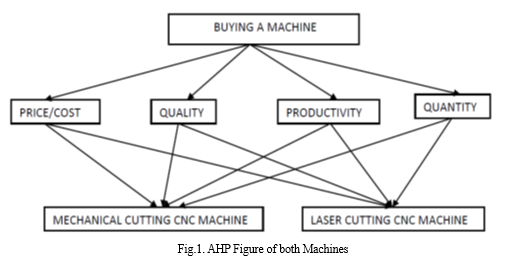
First collect data according to importance of this parameter. This parameter will compare to its equal importance with comparison to other and somewhere moderate, strong, very strong, extremely strong and intermediate values lie. That decides by purchasing machine customer.
After collecting this data use to following these steps:
- Prepare comparison matrix by using authentically collected data.
- Prepare normalized matrix with pair-wise by dividing unique cell data by sum of this column. Then after the criteria value is calculating by summation of each row data.
- Prepare a matrix on based on weighted value for normalized matrix. Unique value of cell in pair-wise matrix is multiply with sequence of column for cross functioning.
- Find consistency index.
- Find consistency ratio.
If the consistency ratio is below 0.10, then we confirm to take decision.

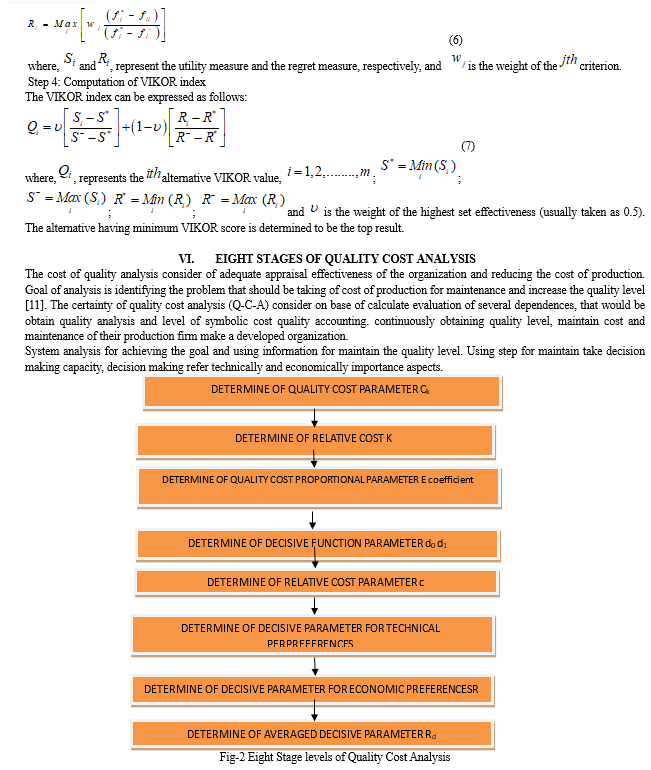

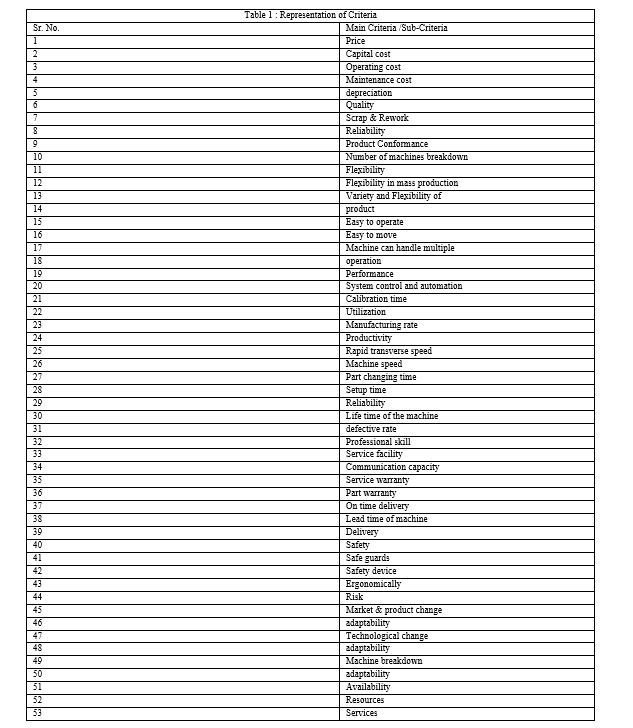
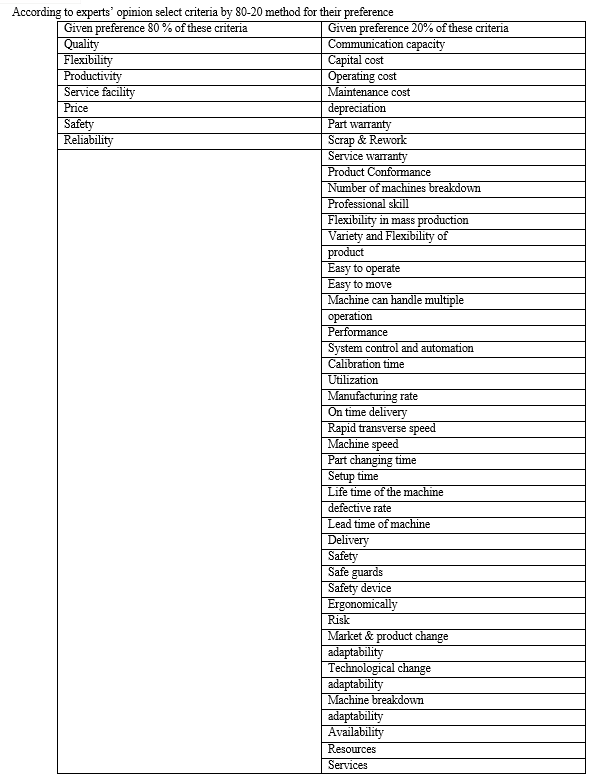
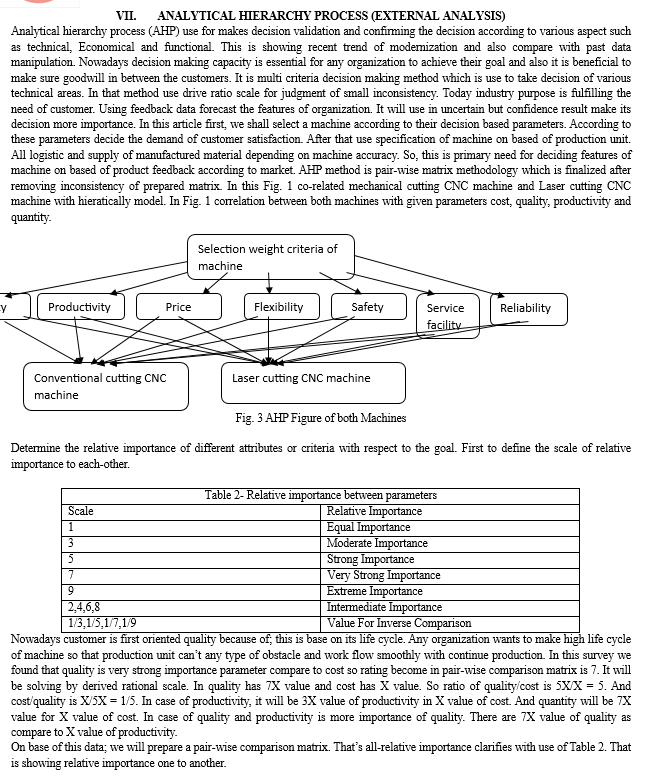

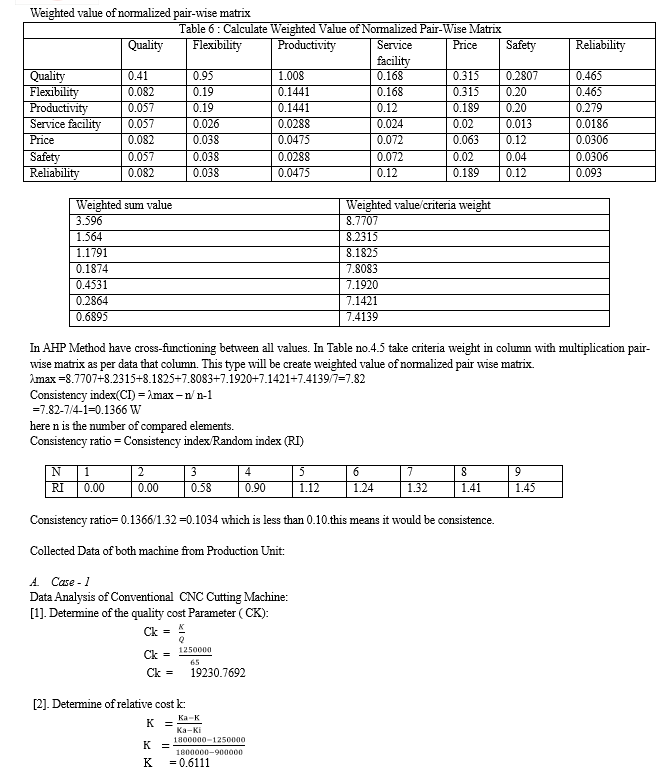
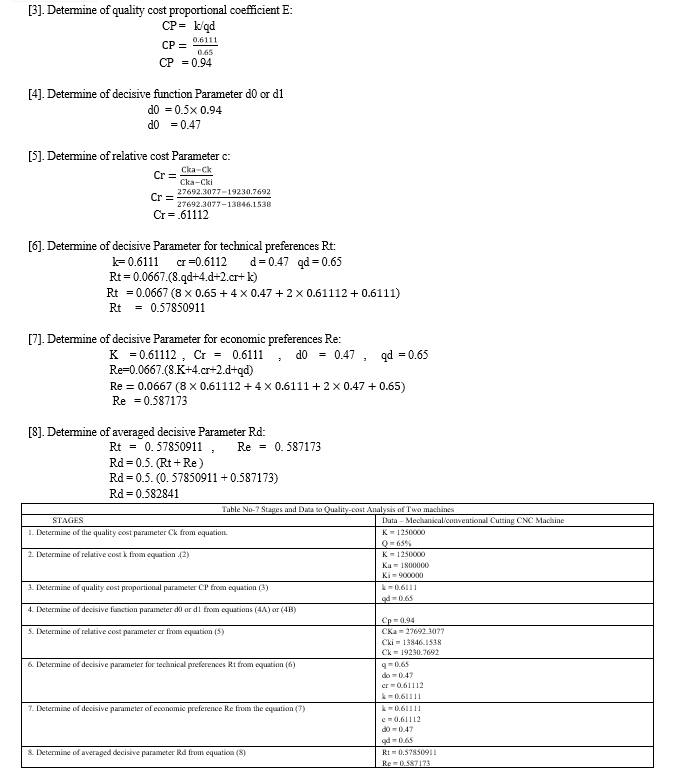 \
\
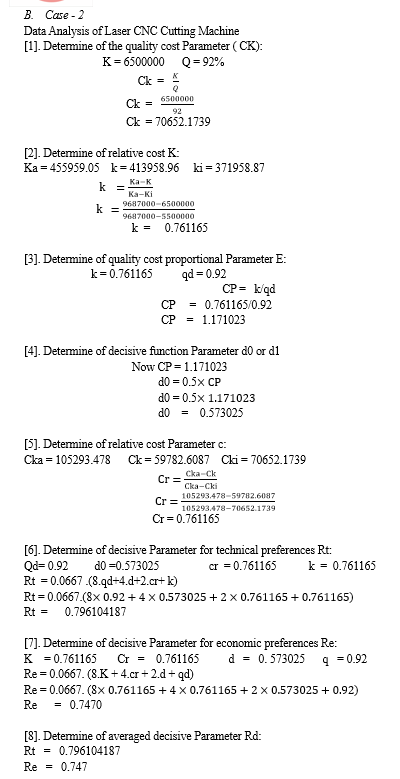
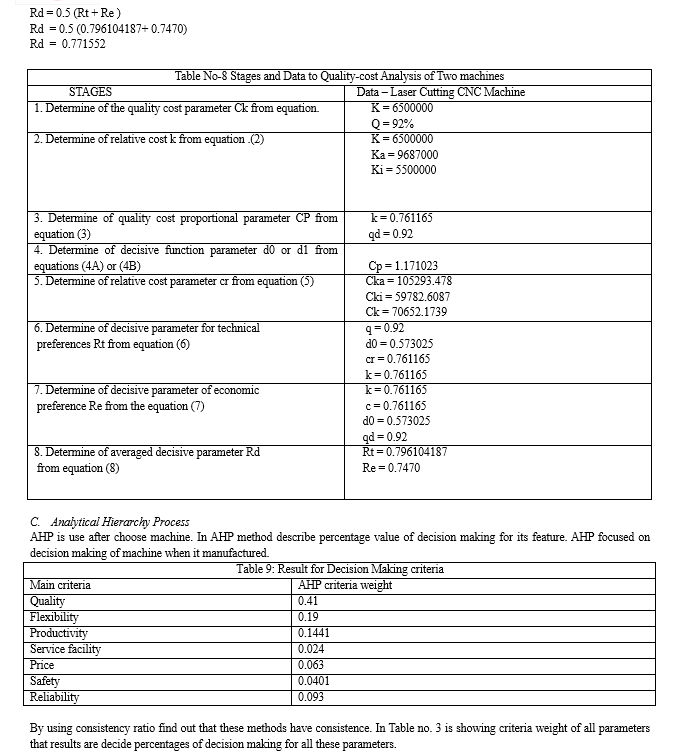
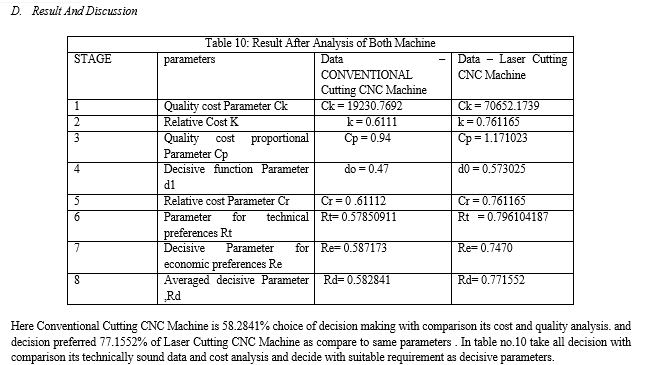
VIII. RESULTS AND DISCUSSION
The results and discussion section of this research paper presents the findings obtained through the application of various methodologies, including the Analytic Hierarchy Process (AHP) for criteria weighting, the VIKOR method for machine selection, and strategies for optimizing the cost of quality (COQ). This section evaluates the effectiveness of these methodologies and discusses their implications for enhancing industrial efficiency and promoting economic growth.
Criteria Weights Determination using AHP
The AHP method was employed to determine the weights of criteria considered essential for machine selection and COQ optimization. Through a systematic process of pairwise comparisons and mathematical calculations, priority weights were assigned to each criterion based on their relative importance. The results revealed the significance of factors such as performance specifications, reliability, cost considerations, and quality assurance in the decision-making process. These weighted criteria provided valuable insights into the key considerations influencing machine selection and COQ management strategies.
Machine Selection Outcome using VIKOR Method
The VIKOR method facilitated the selection of the most suitable machine from the available alternatives based on the established criteria weights. By considering both the best and worst outcomes for each alternative, the VIKOR method identified the compromise solution that offered the best overall performance. The results of the machine selection process highlighted the importance of balancing multiple criteria to achieve optimal outcomes. Additionally, the VIKOR method provided a structured framework for informed decision-making, ensuring that the selected machine aligned with organizational objectives and stakeholder preferences.
A. Cost of Quality Optimization Strategies
The research also investigated various strategies for optimizing the cost of quality within industrial operations. Strategies such as defect prevention, quality assurance, and continuous improvement initiatives were explored to minimize quality-related expenses and maximize benefits. Real-world examples and case studies were utilized to illustrate the application of these strategies in industrial settings, showcasing organizations that have successfully implemented COQ optimization strategies to achieve significant cost savings and performance improvements.
B. Implications for Industrial Efficiency and Economic Growth
The findings of the research have significant implications for enhancing industrial efficiency and promoting economic growth. By employing rigorous methodologies for criteria weighting, machine selection, and COQ optimization, organizations can make informed decisions that drive operational excellence and competitiveness. The strategies and techniques explored in this research offer practical insights into improving production processes, reducing costs, and enhancing overall performance. Ultimately, the adoption of these methodologies can contribute to the sustainable growth and prosperity of industrial enterprises, thereby fostering economic development and prosperity.
Conclusion
In conclusion, this research has shed light on the critical importance of informed decision-making in machine selection and cost of quality (COQ) management for enhancing industrial efficiency and fostering economic growth. Through the application of methodologies such as the Analytic Hierarchy Process (AHP) for criteria weighting and the VIKOR method for machine selection, valuable insights have been gleaned into optimizing industrial operations. The determination of criteria weights provided a structured framework for prioritizing factors influencing machine selection and COQ management, ensuring alignment with organizational objectives. The VIKOR method facilitated the selection of the most suitable machine, considering both the best and worst outcomes for each alternative and balancing multiple criteria to achieve optimal results. Moreover, the exploration of COQ management strategies, including defect prevention, quality assurance, and continuous improvement initiatives, has underscored their significance in minimizing quality-related expenses and maximizing benefits. Real-world examples and case studies have demonstrated the practical application of these strategies in industrial settings, showcasing their potential for driving operational excellence and competitiveness. Looking ahead, future research directions could include further investigation into emerging technologies and trends reshaping the industrial landscape. Additionally, continued emphasis on market analysis and leveraging modern technology trends will be crucial in driving organizational success. By embracing innovation and adopting a proactive approach to decision-making, organizations can position themselves for sustained growth and prosperity in an increasingly competitive global marketplace. Ultimately, the findings of this research underscore the imperative of strategic decision-making in machine selection and COQ management as pivotal drivers of industrial efficiency and economic growth.
References
[1] Feigenbaum, A.V. (1956), “Total quality control”, Harvard Business Review, Vol.34, [2] Juan, J.M. (1951), Quality Control Handbook, 1st edition, McGraw-Hill, New York, [3] Porter, L.J. and Rayners, P.(1992), “Quality costing for total quality management”, International Journal of Production Economics, Vol. 27, p.69 [4] Cooper, R. (1988) The rise of activity-based costing – Part I: what is an activity-based cost system, Journal of Cost Management, 45-54. [5] Warsaw, P.K.N. (2001) ISO 9001:2000 Standard, Quality management systems –Requirements, Vol.16 [6] Johnson, M.A. (1995) The development of measures of the cost of quality for an engineering unit. International Journal of Quality and Reliability Management vol.12,86–100 [7] Crosby, P.B,(1979), quality is free” New American Library New York [8] Sharma, D.D, (2001) Statistical quality control, Sultan Chand and sons Publisher New Delhi. [9] Mitra. Amitava,(2002), Quality control and improvement, 2rd edition published by arrangement with pearson education, Inc, 21-30 [10] Hwang, G.H. & Aspin wall, E.M., (1996). “Quality Cost Models and their applications”, TQM, vol.7, no.3 [11] Kolman, R. (1992) Quality engineering, PWE, Warsaw ,Vol. 16 [12] Jorgenson, D.M. and Enkerlin, M.E. (1992), “Managing quality costs with the help of activity-based costing”, Journal of Electronics Manufacturing, Vol.2, p.153. [13] Mahajan. M. S. Statistical Quality Control. Dhanpat Rai & Co. LTD [14] Plunkett, J.J. and Dale, B.G. (1987), “A review of the literature on quality-related costs”, International Journal of Quality & Reliability Management, Vol.4, No.1, p.40 [15] Tsai, W.H. (1998) Quality cost measurement under activity-based costing, International Journal of Quality & Reliability Management. vol.15, 719-752. [16] Juran, J.M., Gryna, F.M. and Bingham, R. (1975), Quality Control Textbook, 3rd edition, McGraw-Hill, New Yor [17] Michalska, J. S. Tkaczyk. (2002) Analysis of Polish enterprises’ activity in the area of quality costs, 11th International Scientific Conference: Achievements in Mechanical and Materials Engineering, Gliwice-Zakopane. Vol.16 [18] Hwang, G.H. (1996) Quality cost models and their application: a review, Total Quality Management & Business Excellence, vol. 7, 267-282.
Copyright
Copyright © 2024 Rohit Kumar, Nishant Singh Kushwah. This is an open access article distributed under the Creative Commons Attribution License, which permits unrestricted use, distribution, and reproduction in any medium, provided the original work is properly cited.

Download Paper
Paper Id : IJRASET60745
Publish Date : 2024-04-22
ISSN : 2321-9653
Publisher Name : IJRASET
DOI Link : Click Here
 Submit Paper Online
Submit Paper Online

